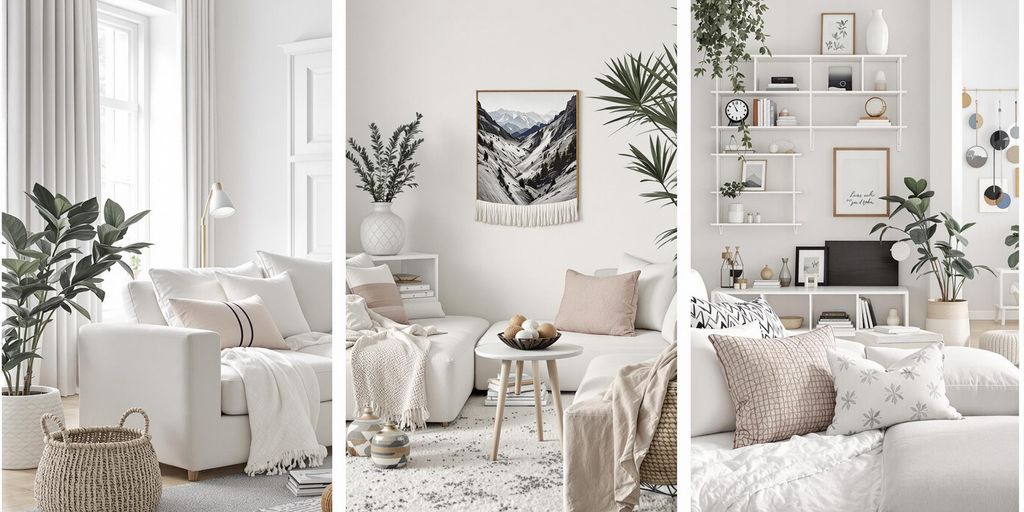Living in a small home doesn’t mean you can’t have big style. With a few smart tricks and some creativity, you can turn your compact space into a cozy and stylish retreat. From kitchens to bathrooms, every inch can be utilized to create a functional and beautiful home. Whether you’re looking to maximize storage or add a splash of color, there are plenty of ways to make your small home feel larger and more inviting.
Key Takeaways
- Small spaces benefit from open shelving, which creates a sense of openness.
- Choosing the right furniture is crucial in small living rooms to prevent overcrowding.
- Light colors in bedrooms can make the space feel airy and more spacious.
- Floating vanities in bathrooms save space and add a modern touch.
- Vertical gardens are perfect for adding greenery to small outdoor areas.
Maximizing Space in Tiny Kitchens
Open Shelving for a Spacious Feel
Open shelving can be a game-changer for tiny kitchens. Instead of bulky cabinets, consider installing open shelves to create a sense of openness. They not only make your kitchen look bigger but also give you easy access to your everyday items. Keep your shelves organized with matching jars and containers for a neat look. You can also add a pop of color with some decorative items or plants.
Smart Storage Solutions
When space is limited, smart storage solutions are your best friend. Think about using vertical space with wall-mounted shelves or hooks for hanging pots and pans. Invest in IKEA products like in-sink drying racks and stackable cabinet organizers to make the most of every inch. Here are some ideas:
- Use magnetic strips to hold knives and other metal tools.
- Install pull-out shelves in your cabinets to reach items at the back easily.
- Consider a rolling cart that can be moved around as needed.
Color Schemes to Enlarge Your Space
The right color scheme can make a tiny kitchen feel larger. Stick to light colors like whites, creams, and pastels to reflect more light. You might want to add some bold accents for personality, but keep them minimal to avoid overwhelming the space. A monochromatic scheme can also help in creating a cohesive look that feels airy and open.
A small kitchen doesn’t have to feel cramped. With thoughtful design choices, you can create a space that’s both functional and stylish, making your tiny kitchen a delightful place to cook and gather.
Living Room Hacks for Small Spaces

Choosing the Right Furniture
When it comes to small living rooms, picking the right furniture is key. You don’t want pieces that are too big or too small. Go for a sofa that fits just right, like a loveseat or a sectional that hugs the corners. This way, you can maximize seating without crowding the space. Consider a sofa with built-in storage to tuck away blankets or magazines. Choosing the right sofa scale is essential for living room layouts, whether it’s matching loveseats in smaller spaces or larger sofas and sectionals in bigger areas.
Layering Textures and Patterns
Textures and patterns can add depth to a small room. Mix and match throws, cushions, and rugs to create a cozy vibe. Start with a neutral base, then layer on different fabrics like wool, cotton, or linen. Patterns like stripes or small florals can make the space feel lively without overwhelming it. Just keep the colors in the same family to avoid a chaotic look.
Creating a Focal Point
Every room needs a focal point, and in a small living room, it can be as simple as a piece of art or a unique coffee table. This draws the eye and gives the room a sense of purpose. You might also consider a gallery wall or a striking rug to anchor the space. Remember, the goal is to make the room feel inviting and put together without feeling cramped.
Bedroom Ideas to Make Your Space Feel Bigger

Using Light Colors for an Airy Feel
Alright, let’s talk colors. Light shades are your best friend when you’re trying to make a small bedroom feel bigger. Whites, pastels, and soft hues can really open up your space. They reflect more light, which makes the room feel airy and spacious. Think of it like this: a room painted in light tones is like a blank canvas that feels endless. If you’re feeling adventurous, try a monochromatic scheme with different shades of the same color. This can create a seamless look that makes the room appear larger.
Multi-Functional Furniture
When space is tight, every piece of furniture should work double duty. Look for beds with built-in storage or a desk that can also serve as a vanity. The key is to maximize utility without cramming the room. Consider a larger mattress and center the bed near a window to give the illusion of more space. Lowering the bed height can also make the ceiling feel higher, adding to the room’s overall spaciousness.
Creative Storage Solutions
Storage can be a real challenge in small bedrooms, but with a bit of creativity, you can keep things neat and tidy. Use vertical space to your advantage—install shelves high up for items you don’t need every day. Hooks on the wall can hold bags or hats, and under-bed storage is a lifesaver for seasonal clothes. A storage bench at the foot of the bed can hide away extra blankets and pillows while giving you a place to sit. Remember, a clutter-free room always feels bigger!
Bathroom Decor Tips for Small Homes
Opt for Floating Vanities
Floating vanities are a game-changer for small bathrooms. They free up floor space, making the room feel less cramped. Plus, they give you that modern, sleek look. Think about it: more space for your feet, and it looks super chic. Consider pairing your floating vanity with a polished nickel faucet for a touch of elegance. Don’t forget to utilize the space underneath for storage baskets or bins.
Use Mirrors to Create Illusion of Space
Mirrors are your best friend in a small bathroom. A large mirror can reflect light and make the space feel twice as big. Try placing a mirror opposite a window to maximize the natural light. You might even consider a backlit mirror for added depth and a cool, contemporary vibe. For a stylish touch, explore options like brass mirrors and black cabinet hardware to complement your bathroom decor.
Compact Storage Ideas
Storage is crucial in a small bathroom, but it doesn’t have to be boring. Wall-mounted shelves are a great way to keep things organized without taking up floor space. Look for compact, stylish shelves that add both function and flair. You can also use the vertical space above your toilet for additional storage. Think about adding a few hooks for towels or robes, too. Every inch counts!
Decorating Small Outdoor Spaces
Vertical Gardens for Greenery
Got a small outdoor space but still want that lush, green vibe? Vertical gardens are your best friend! They let you plant upwards, saving precious floor space. Think about using wall-mounted planters or even repurposing an old ladder to hang your pots. Vertical gardens not only save space but also add a unique, stylish touch to your outdoor area. Plus, they’re super easy to maintain once set up.
Space-Saving Furniture
When it comes to furnishing your small outdoor area, it’s all about choosing pieces that are both functional and compact. Look for foldable chairs and tables that can be easily stored when not in use. Or consider benches with built-in storage—perfect for stashing away cushions or gardening tools. Here’s a quick list of space-saving furniture ideas:
- Foldable bistro sets
- Stackable chairs
- Benches with storage
- Multi-purpose ottomans
Lighting to Enhance Ambiance
Lighting can really transform your small outdoor space, making it feel cozy and inviting. Opt for solar-powered string lights or lanterns to keep things eco-friendly and low-maintenance. You could also use LED candles for a warm glow without the worry of open flames. A few well-placed lights can highlight your favorite features and create an inviting atmosphere for evening gatherings.
Even the tiniest balcony can become a charming oasis with the right touches. It’s all about maximizing what you’ve got and adding elements that bring you joy. Whether it’s through clever furniture choices or a splash of greenery, your small outdoor space can be just as inviting as a larger one.
Creative Ways to Divide Small Spaces
Using Room Dividers Effectively
Got a small space that needs some separation? Room dividers are your best friend. They’re not just for privacy; they can add style and function too. Think of them as a tool to define different areas without building walls. You can use open shelving units as dividers, which not only separate spaces but also provide extra storage. Another idea is to use folding screens—they’re flexible and can be moved around easily. For a more permanent solution, consider sliding doors that can open up or close off areas as needed.
Creating Zones with Rugs
Rugs aren’t just for warmth—they’re fantastic for defining zones in open-plan spaces. You can use them to mark out a living area, dining space, or even a cozy reading nook. Pick rugs in different textures or colors to create visual boundaries. For a small apartment, layering rugs can add depth and interest, making the space feel larger. Plus, they’re easy to change if you fancy a new look!
Curtains as Flexible Partitions
Curtains are a super versatile option for dividing spaces. They’re light, easy to install, and can be drawn back when you want to open up the space. Use them to separate a sleeping area from the rest of your studio apartment, or to create a little privacy in a shared room. You can go for sheer curtains to keep things light and airy, or heavy drapes for more privacy. They’re an affordable way to change up your space without committing to anything permanent.
Dividing a small space doesn’t mean you have to sacrifice style. With the right tools, you can create distinct areas that not only look great but also make your home more functional. Whether you’re using room dividers or simply laying down a rug, these small changes can make a big difference.
Personalizing Your Small Home with Decor
Incorporating Art and Accessories
Adding art and accessories is a fantastic way to make your home feel more personal. Think about hanging a mix of family photos, abstract prints, or even a beautiful oil painting on your walls. This not only adds color but also tells your story. You don’t need to go overboard; sometimes less is more. Choose pieces that speak to you and fit the overall vibe of your space.
Choosing Statement Pieces
When space is tight, every piece of furniture or decor needs to count. So, why not make it a statement? A bold rug or a unique light fixture can become the focal point of a room. These elements draw the eye and can make your home feel curated and intentional. Just remember to balance bold pieces with more neutral surroundings to avoid a cluttered look.
Mixing Vintage and Modern Styles
Mixing styles is a fun and effective way to personalize your space. Combine vintage finds with modern pieces to create a unique look that’s entirely yours. Maybe pair a sleek, modern sofa with a vintage coffee table. It’s all about striking the right balance. This blend of old and new not only adds character but also makes your home feel cozy and lived-in.
Personalizing your home is all about making it feel like you. Whether it’s through art, furniture, or a mix of styles, the key is to choose what you love and what makes you happy. Don’t be afraid to experiment—your home should be a reflection of who you are.
Color Trends for Small Homes in 2025
Embracing Soft Pastels
In 2025, designers forecast that soft pastels will become the go-to choice for small homes. These gentle hues, like blush pink, soft lavender, and light mint, can make any room feel larger and more inviting. Pastels have a magical way of reflecting light, giving even the tiniest spaces a bright and airy vibe. They’re perfect for creating a calming environment, which is exactly what you need in a bustling world.
Bold Accents for Personality
While pastels are set to dominate, bold accents are not to be overlooked. Think deep burgundy, moody purple, or even a splash of bright yellow. These colors can add a pop of personality to your space without overwhelming it. Consider using them in small doses—like a feature wall, a piece of furniture, or even just some throw pillows. It’s all about balance!
Monochromatic Schemes for Cohesion
Monochromatic color schemes are a fantastic way to create a cohesive look in a small home. By sticking to one color and using different shades and tones, you can achieve a seamless flow from room to room. This approach minimizes visual clutter and makes spaces feel more open. Opt for earth tones or soft browns for a warm and inviting atmosphere. It’s like wrapping your home in a cozy blanket of color.
When choosing colors for small spaces, remember: less is more. A simple, well-thought-out color palette can transform a cramped room into a stylish sanctuary. Let your colors speak softly but with intention.
Wrapping It Up
So there you have it, a hundred ways to jazz up your small home in 2025. Whether you’re into sleek modern vibes or cozy vintage feels, there’s something here for everyone. Remember, it’s all about making the most of what you’ve got. Small spaces can be tricky, but with a bit of creativity and the right decor, they can be just as stylish and functional as any big house. So go ahead, try out some of these ideas, and make your home a place you love to be. Happy decorating!
Frequently Asked Questions
How can I make my small kitchen feel bigger?
Use light colors and open shelving to create a sense of space. Smart storage solutions can also help keep the area tidy.
What kind of furniture is best for small living rooms?
Choose furniture that is multi-functional, like a sofa bed, and avoid oversized pieces that can overwhelm the space.
How do I make a small bedroom look airy?
Stick to light colors and use mirrors to reflect light and create the illusion of more space.
What are some storage ideas for small bathrooms?
Opt for floating vanities and compact storage solutions to maximize floor space.
How can I decorate a small outdoor area?
Use vertical gardens and space-saving furniture to make the most of your outdoor space.
What colors are trendy for small homes in 2025?
Soft pastels, bold accents, and monochromatic schemes are popular choices for small spaces.


